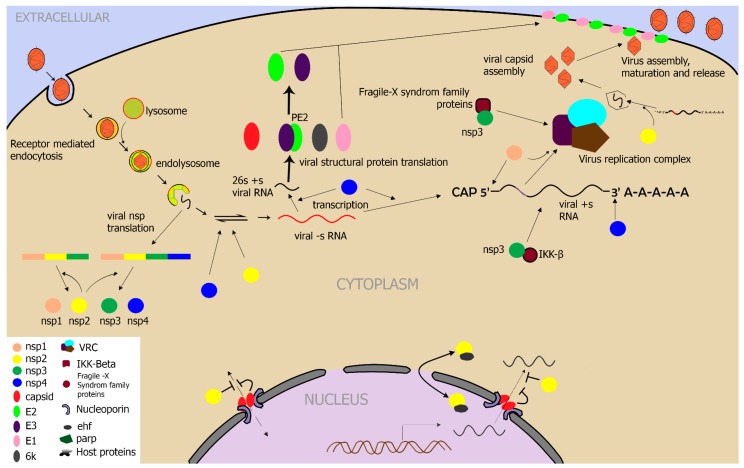Figure 4.
Replication of VEEV in host cell. VEEV enters in the host cells by receptor mediated binding of the virus to the host cell membrane. Virus containing endosomes fuse with lysosomes resulting in formation of endolysosomes. Viral RNA is released in the cytoplasm following pH dependent conformational changes in the viral proteins, allowing fusion with the endolysosome membrane. VEEV is a single-stranded positive-sense RNA virus that replicates in the cytoplasm and does not have a nuclear phase of replication. In the second phase of infection, viral nsp are translated as P123 and P1234 polyproteins from the viral genomic RNA. Autolytic activity of nsp-2 cleaves the viral polyproteins in individual nsp-1, nsp-2, nsp-3, and nsp-4 proteins. Nsp-4 is a viral RdRp, which with methyltransferase activity of nsp-2, drives synthesis of negative-sense viral RNA. Negative-sense viral RNA is transcribed into smaller 26S subgenomic positive-sense RNA and a full-length positive-sense viral RNA. Subgenomic 26S RNA is translated into viral structural proteins namely capsid, a polyprotein of E3 and E2 called PE2, 6k, and E1. PE2 is processed into E3 and E2 proteins by cutting at the furin-cleavage site in PE2. Viral nsp-2 plays a role in capping of viral genomic RNA via its methyltransferase and guanylylation activity. Nsp-4 adds a poly-A tail to the viral genomic RNA via its terminal adenyltransferase activity. Full length positive- sense viral RNA is incorporated into a virus replication complex (VRC). Assembly of VRC is aided by interaction of viral non-structural proteins with host proteins such as nsp-3 with IKK-β and Fragile- X syndrome family proteins. Nsp-3 binds to other unknown host proteins during formation of VRC, the role of which is not yet understood. Nsp-1 conserved sequence element helps in the recognition of the core promoter element of the virus genome by VRC. In addition to direct involvement of viral proteins in replication and assembly, viral non-structural proteins interact with host factors to promote VEEV replication. Capsid proteins bind to components of the nuclear pore complex effectively blocking nuclear-cytoplasm-nuclear traffic and host protein translation. Nsp-2 interacts with karyopherin-alpha 1 for its nuclear localization function, role of which is not clearly understood. Nsp2 plays a role in loading of the viral RNA into nucleocapsid and maturation of virions. In the final step structural proteins E1 and E2 are embedded in the plasma membrane, and assembly and release of the mature virion particle occurs by encapsulating nucleocapsid and budding at plasma membrane [2].

